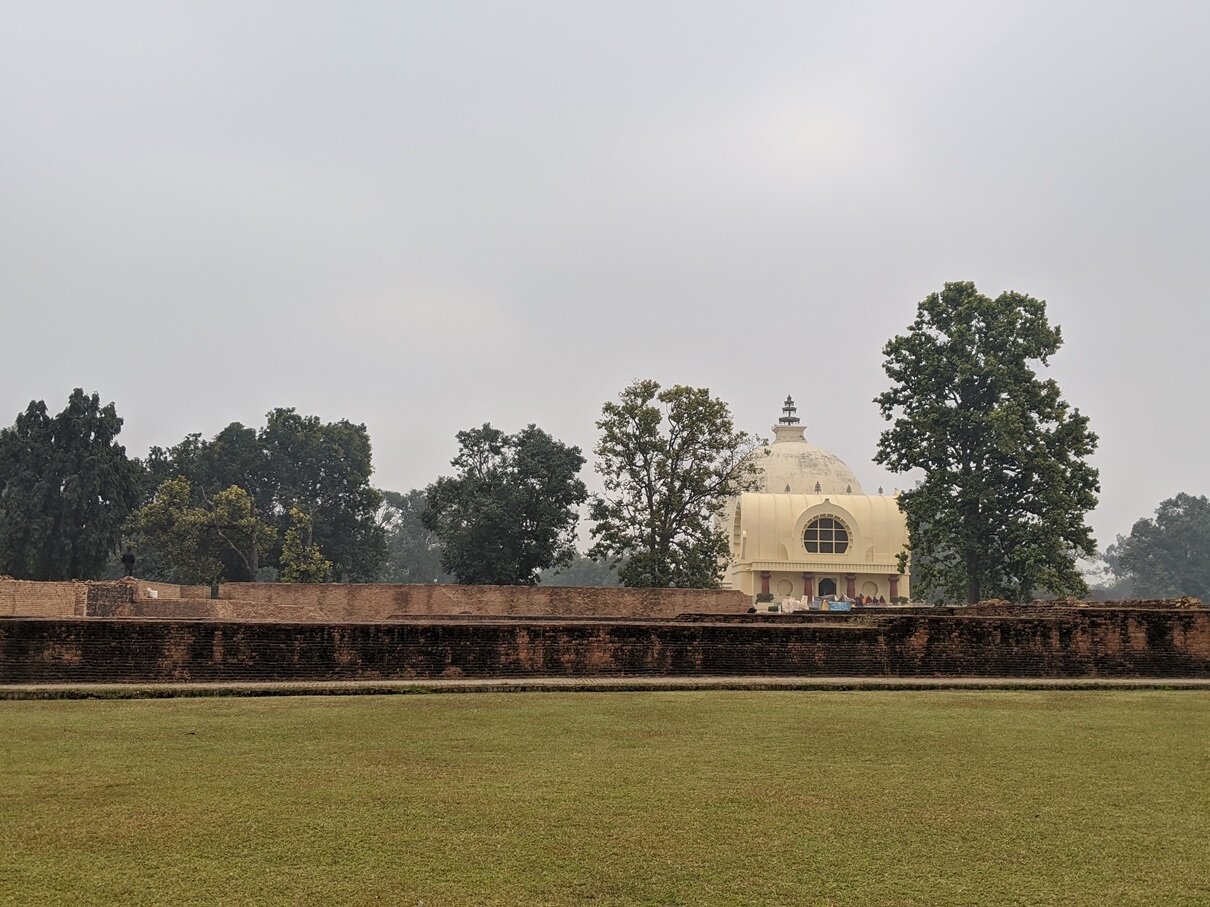
Kusinārā
Where the Buddha was totally unbound in the remainderless property of Unbinding.
Kusinārā (pali) or Kushinagar, Kusinagara is a town in the Kushinagar district of the Indian state of Uttar Pradesh. It is in the Northeast area of India.
This is the place where Lord Buddha chose for his Maha-parinibbana or Final Release from the round of samsara (the continuous round of births and deaths). The Mahaparinibbana Sutta records the events and significant teachings during the last year of the Buddha’s life.
Main points of interest in the Kushinagar area include:
Mahaparinibbana Temple
Mahaparinibbana or Nirvana Stupa
Matha Kuwara Shrine
Cremation Stupa (Ramabhar Stupa) or Makutabandhana Cetiya (which is to the East)
Site of distribution of the relics of the Buddha after the cremation.
and other sites relating to the Buddha’s Maha Parinibbana.
This web page mainly introduces the Mahaparinibbana Temple and Stupa, the Cremation Stupa, and the Relics distribution site. Alongside are excerpts from the Mahaparinibbana Sutta which narrates the events of the year leading up to the Buddha’s parinibbāna and the weeks immediately following it.
The gate on the left is to the Stupa’s West.
The Buddha’s Last Words
Three months before he reached the age of eighty, Lord Buddha renounced his will to live at the Capala Shrine in Vesali. Walking in stages via Pava where he ate his last meal offered by the iron smith Cunda, he reached the final resting-place at the Sala grove of the Mallas by the bank of the Hirannavati river in Kusinārā. There, on the full-moon day of Visakha (Vesak) in 543 BC, the Buddha attained his Mahaparinbbana (the Great Final Release from the cycle of rebirths), hence releasing him from continued wandering in Samsara. His last convert was the wandering ascetic Subhadda and his last words were:
“Āmantayāmi vo bhikkhave,
Paṭivedayāmi vo bhikkhave:
I address you, monks,
I inform you, monks:
Khaya-vaya-dhammā saṅkhārā,
Appamādena sampādethāti.
Processes are subject to passing away.
Become consummate
Through heedfulness.”
Then the Buddha lapsed into the jhana stages, or meditative absorptions. Going from level to level, one after the other, ever deeper and deeper. Then he came out of the meditative absorption for the last time and passed into nirvana, leaving nothing whatever behind that can cause rebirth again in this or any other world. The passing away, or the final nirvana of the Buddha, occurred in 543BC on a full-moon day in the month of May, known in the Indian calendar as Vesak.
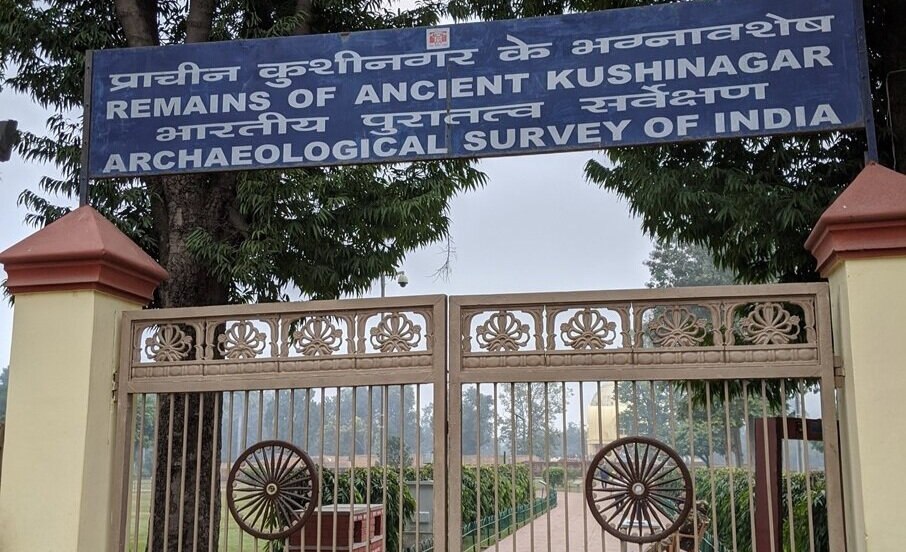
Mahaparinibbana or Nirvana Temple and Stupa
Source: Image of buda Parinirvana (January 2007) https://en.wikipedia.org/wiki/File:Mahaparinirvana.jpg
Inside the Mahaparinibbana Temple
The present Temple was built by the Indian Government in 1956 as part of the Commemoration of the 2,500th year of the MahaParinibbana or 2,500 BE (Buddhist Era). Inside this temple, one can see the famous Reclining Buddha image lying on its right side with the head to the north. The statue is 6.1m long and rests on a 7.3m long stone couch. On the front side of the couch are three sculptures, believed to represent Ven. Ananda near the feet, Ven. Subhadda at the middle and Ven. Dabba Mala at the other corner.
At the centre is an inscription of the 5th century AD, which states that the statue was “a gift of the monk Haribala to the Mahavihara and that it was fashioned by Dinna”. This 1,500-year old Reclining Buddha image was executed out of one block of red sandstone brought in from Mathura during the Gupta period. It was Carlleyle (a British archaeologist) who discovered it in 1876 in a dilapidated condition and successfully pieced together the fragments found scattered about. This statue bears the 32 marks of the Great Man (Mahapurisa) and can evoke different feelings in one’s mind, depending on where one stands to look at it:
1. In the front of the face, one can discern a smiling mood in the face.
2. Near the middle part of the body, one can discern a mood of suffering.
3. At the feet, one can discern the calm and serenity in the face.
The total unbinding
(excerpts from the Mahaparinibbana Sutta)
When the Blessed One totally unbound, simultaneously with the total unbinding, some of the monks present who were not without passion wept, uplifting their arms. As if their feet were cut out from under them, they fell down and rolled back & forth, crying, “All too soon has the Blessed One totally unbound! All too soon has the One Well-Gone totally unbound! All too soon has the One with Eyes disappeared from the world!” But those monks who were free from passion acquiesced, mindful & alert: “Inconstant are fabrications. What else is there to expect?”
Then Ven. Anuruddha addressed the monks, “Enough, friends. Don’t grieve. Don’t lament. Hasn’t the Blessed One already taught the state of growing different with regard to all things dear & appealing, the state of becoming separate, the state of becoming otherwise? What else is there to expect?52 It’s impossible that one could forbid anything born, existent, fabricated, & subject to disintegration from disintegrating. The devatās, friends, are complaining.”
[Ven. Ānanda:] “But, Ven. Anuruddha, what is the state of the devatās you are paying attention to?”
“Friend Ānanda, there are devatās who perceive space to be earth. Tearing at their hair, they are weeping. Uplifting their arms, they are weeping. As if their feet were cut out from under them, they fall down and roll back & forth, crying, ‘All too soon has the Blessed One totally unbound! All too soon has the One Well-Gone totally unbound! All too soon, has the One with Eyes disappeared from the world!’ Then there are devatās who perceive earth to be earth. Tearing at their hair, they are weeping. Uplifting their arms, they are weeping. As if their feet were cut out from under them, they fall down and roll back & forth, crying, ‘All too soon has the Blessed One totally unbound! All too soon has the One Well-Gone totally unbound! All too soon has the One with Eyes disappeared from the world!’ But those devatās who are free from passion53 acquiesce, mindful & alert: ‘Inconstant are fabrications. What else is there to expect?’”
Then Ven. Anuruddha & Ven. Ānanda spent the remainder of the night in Dhamma talk.
Mahaparinibbana or Nirvana Stupa
This stupa, behind the Mahaparinibbana Temple, is a restoration of the Main stupa exposed during excavations in 1876. When examined to a depth of 4.3m, it revealed a copper plate and other objects from the Gupta period. The inscription on the plate in Sanskrit mentioned that the objects were deposited in the Nirvana Stupa by the monk Haribala. The Nirvana stupa, is believed to be erected originally by the Mallas (they were also given one of the eight portions of the Buddha’s relics by the Brahmin Dona), to enshrine the Buddha’s relics, and subsequently enlarged by King Asoka and later during the Gupta period.
Right behind the Nirvana chedi is the base of another chedi and it is believed that the Buddha’s body was kept here while awaiting cremation.
Moving the Buddha’s Body to Makuta Bandhana
(excerpts from the Mahaparinibbana Sutta)
Then eight leading Mallans, having bathed their heads and wearing new linen cloth, thinking, “We’ll lift up the Blessed One’s body,” were unable to lift it. So the Kusinārā Mallans asked Ven. Anuruddha, “What is the reason, Ven. Anuruddha, what is the cause, why these eight leading Mallans, having bathed their heads and wearing new linen cloth, thinking, ‘We’ll lift up the Blessed One’s body,’ are unable to lift it?”
“Your intention, Vāsiṭṭhas, is one thing. The devas’ intention is another.”
“But what, Ven. Anuruddha, is the devas’ intention?”
“Your intention, Vāsiṭṭhas, is, ‘Worshipping, honoring, respecting, & venerating the Blessed One’s body with dances, songs, music, garlands, & scents, let’s carry it to the south, around the outside of the town, and cremate it to the south of the town.’ The devas’ intention is, ‘Worshipping, honoring, respecting, & venerating the Blessed One’s body with heavenly dances, songs, music, garlands, & scents, lets carry it to the north of the town, enter the town through the north gate, carry it through the middle of the town and out the east gate to the Mallans’ shrine called Makuṭa-bandhana, to cremate it there.’”
“Then let it be, venerable sir, in line with the devas’ intention.”
…
The Ven. Ananda explained what the Buddha had told him concerning the cremation arrangements.
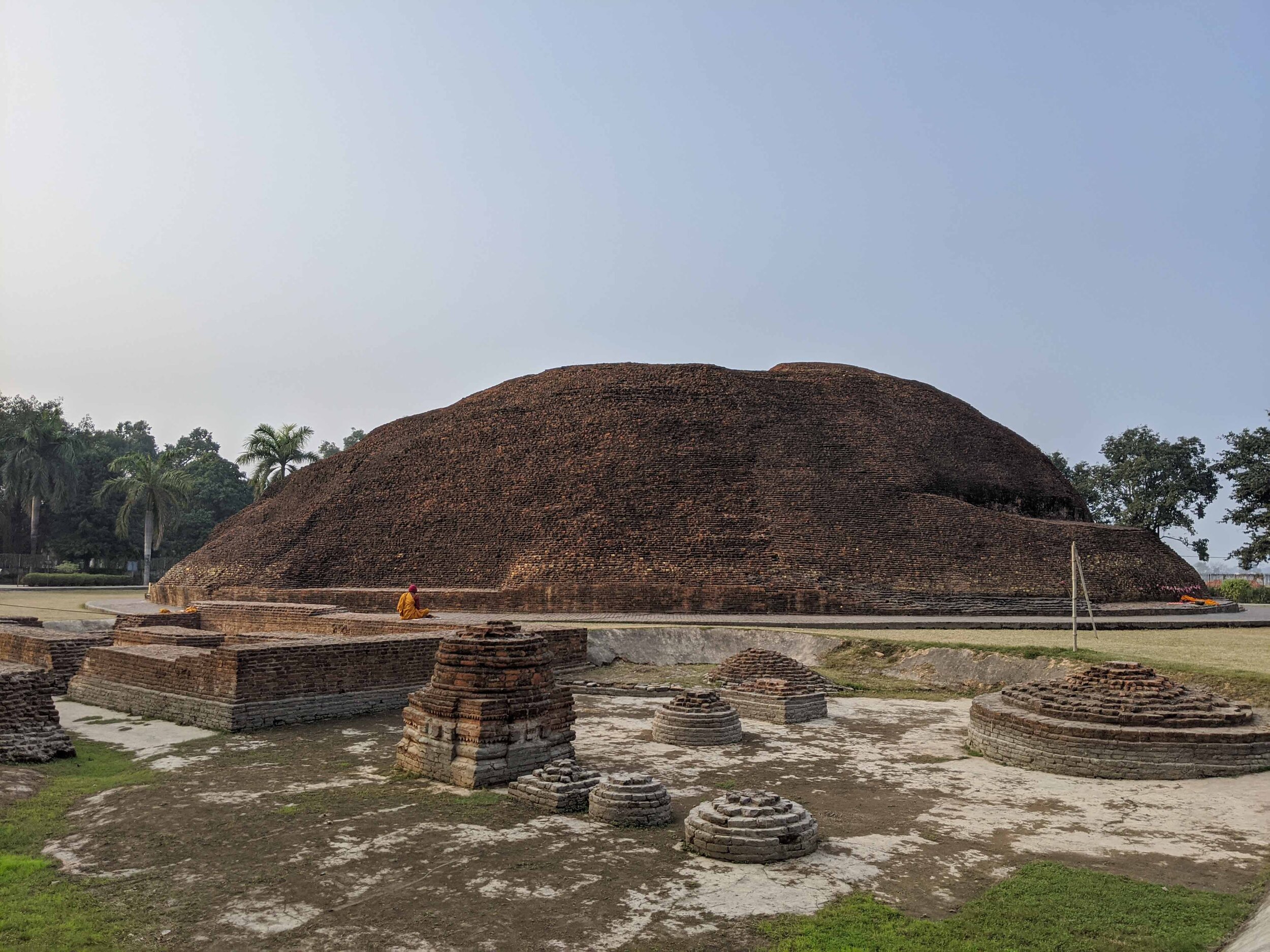
Ramabhar Stupa
Cremation Stupa, also called a Mukutbandhan-Chaitya, is the cremation place of Buddha.
This site is 1.5 km east of the main Nirvana Temple on the Kushinagar-Deoria road.
The cremation
(excerpts from the Mahaparinibbana Sutta)
Then four leading Mallans, having bathed their heads and wearing new linen cloth, thinking, “We’ll ignite the Blessed One’s pyre,” were unable to ignite it. So the Kusinārā Mallans asked Ven. Anuruddha, “What is the reason, Ven. Anuruddha, what is the cause, why these four leading Mallans, having bathed their heads and wearing new linen cloth, thinking, ‘We’ll ignite the Blessed One’s pyre,’ are unable to ignite it?”
“Your intention, Vāsiṭṭhas, is one thing. The devas’ intention is another.”
“But what, Ven. Anuruddha, is the devas’ intention?”
“The devas’ intention, Vāsiṭṭhas, is, ‘This Ven. Mahā Kassapa is traveling on the highway from Pāvā to Kusinārā with a large Saṅgha of monks, approximately 500 monks in all. The Blessed One’s pyre will not catch fire until Ven. Mahā Kassapa has worshipped the Blessed One’s feet with his bathed head.’”
“Then let it be, venerable sir, in line with the devas’ intention.”
So Ven. Mahā Kassapa went to the Blessed One’s pyre at Makuṭa-bandhana, the Mallans’ memorial near Kusinārā. On arrival, arranging his robe over one shoulder, he placed his hands palm-to-palm over his heart, circumambulated the pyre three times, uncovered the Blessed One’s feet,56 and worshipped them with his head. And the 500 monks, arranging their robes over one shoulder, placed their hands palm-to-palm over their hearts, circumambulated the pyre three times, and worshipped the Blessed One’s feet with their heads. As soon as it had been worshipped by Ven. Mahā Kassapa and the 500 monks, the Blessed One’s pyre caught fire of its own accord. In the burning of the Blessed One’s body, no cinder or ash of the outer skin, inner skin, flesh, tendons, or oil of the joints could be discerned. Only the bone-relics57 remained. Just as in the burning of ghee or oil, no cinder or ash can be discerned; in the same way, in the burning of the Blessed One’s body, no cinder or ash of the outer skin, inner skin, flesh, tendons, or oil of the joints could be discerned. Only the bone-relics remained. And of the five hundred twin-wrappings, only two were burnt: the innermost & the outermost.
When the Blessed One’s body was consumed, a cascade of water falling from the sky extinguished [nibbāpesi] the Blessed One’s pyre. Water shooting up from a Sal tree as well extinguished the Blessed One’s pyre. The Kusinārā Mallans, with all kinds of scented water, extinguished the Blessed One’s pyre. Then for seven days the Kusinārā Mallans kept the bone-relics in their reception hall—setting them round with a lattice of spears surrounded by ramparts of bows—worshipping, honoring, respecting, & venerating them with dances, songs, music, garlands, & scents.

Aniruddhawa
Buddha’s Relic Distribution Site
After the cremation
(excerpts from the Mahaparinibbana Sutta)
Then King Ajātasattu Vedehiputta of Magadha heard, “The Blessed One, they say, has totally unbound in Kusinārā.” So he sent an envoy to the Kusinārā Mallans: “The Blessed One was a noble warrior. I, too, am a noble warrior. I deserve a share of the Blessed One’s bone-relics. I, too, will build a burial mound and hold a ceremony for them.”
The Licchavis of Vesālī, The Sakyans of Kapilavatthu, The Thulayans of Allakappa, The Koḷiyans of Rāmagāma, The Brahman of Veṭṭha Island, and The Pāvā Mallans all wanted a share of the relics.
When this was said, the Kusinārā Mallans said to the groups & factions, “The Blessed One totally unbound within the borders of our own town. We will not give up a share of the Blessed One’s bone-relics.”
When this was said, Doṇa the brahman addressed the groups & factions,
“Listen, good sirs, to a word from me.
Our Awakened One was a teacher of forbearance.
It’s not good that there should be combat over the sharing of the relics of the highest person.
Let us, masters, unite in concord, on friendly terms, and make eight shares.
Let there be burial mounds in the various directions,
many people made confident in the One with Eyes.”“In that case, brahman, you yourself divide the Blessed One’s bone-relics into eight equal shares.”
Responding, “As you say, good sirs,” to the groups & factions, Doṇa the brahman divided the Blessed One’s bone-relics into eight equal shares and then said to the groups & factions, “Good sirs, give me this urn. I will build a burial mound and hold a ceremony for the urn.” They gave him the urn.
Then the Moriyans of Pipphalivana heard, “The Blessed One, they say, has totally unbound in Kusinārā.” So they sent an envoy to the Kusinārā Mallans: “The Blessed One was a noble warrior. We, too, are noble warriors. We deserve a share of the Blessed One’s bone-relics. We, too, will build a burial mound and hold a ceremony for them.”
“There is no (remaining) share of the Blessed One’s bone-relics. They have been divided. Take the ashes from here.” They took the ashes from there.
Then King Ajātasattu Vedehiputta of Magadha built a burial mound and held a ceremony for the Blessed One’s relics in Rājagaha.
The Licchavis of Vesālī built a burial mound and held a ceremony for the Blessed One’s relics in Vesālī.
The Sakyans of Kapilavatthu built a burial mound and held a ceremony for the Blessed One’s relics in Kapilavatthu.
The Thulayans of Allakappa built a burial mound and held a ceremony for the Blessed One’s relics in Allakappa.
The Koliyans of Rāmagāma built a burial mound and held a ceremony for the Blessed One’s relics in Rāmagāma.
The brahman of Veṭṭha Island built a burial mound and held a ceremony for the Blessed One’s relics on Veṭṭha Island.
The Pāvā Mallans built a burial mound and held a ceremony for the Blessed One’s relics in Pāvā.
The Kusinārā Mallans built a burial mound and held a ceremony for the Blessed One’s relics in Kusinārā.
Doṇa the brahman built a burial mound and held a ceremony for the urn.
The Moriyans of Pipphalivana built a burial mound and held a ceremony for the embers in Pipphalivana.Thus there were eight burial mounds for the bone-relics, a ninth for the urn, and a tenth for the embers.
That is how it was in the past.
Eight portions were the relics of the One with Eyes, the highest, the foremost of men:
seven honored in Jambudīpa,
and one in Rāmagāma honored by kings of the nāgas.
One tooth the Devas of the Thirty-three worship;
one is honored in Gandhārapura;
one in the realm of the king of Kāliṅga;
another is honored by kings of the nāgas.These, with their splendor, their excellent gifts, embellish this wealth-bearing earth.
Thus the relics of the One with Eyes are honored by those honored by those who are honored.
He is worshiped by deva kings, nāga kings, human kings, and likewise is worshiped by the most excellent people.
So pay homage to him, with hands palm-to-palm over the heart, for the Awakened are rarely encountered in the course of one hundred eons.58
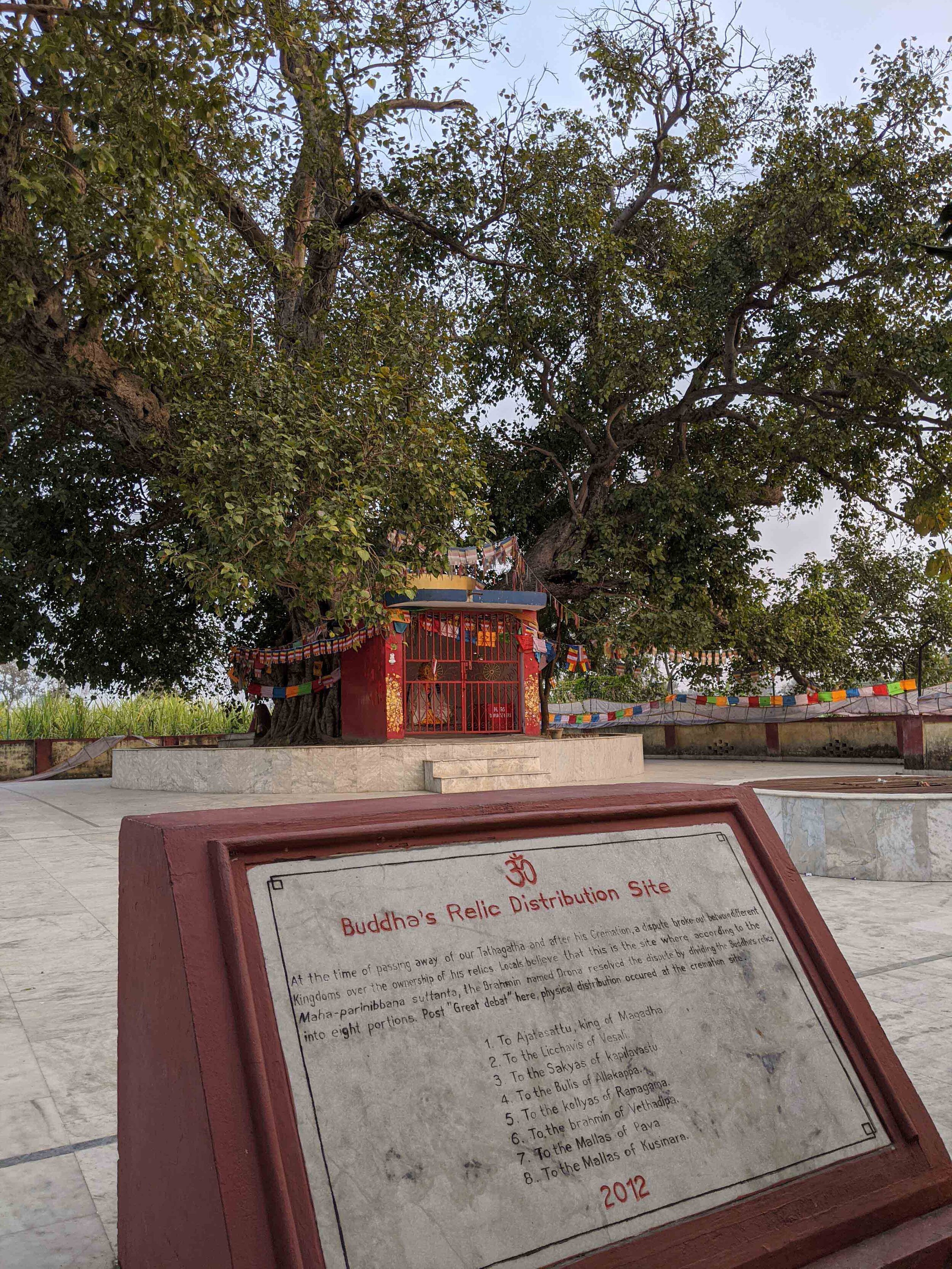

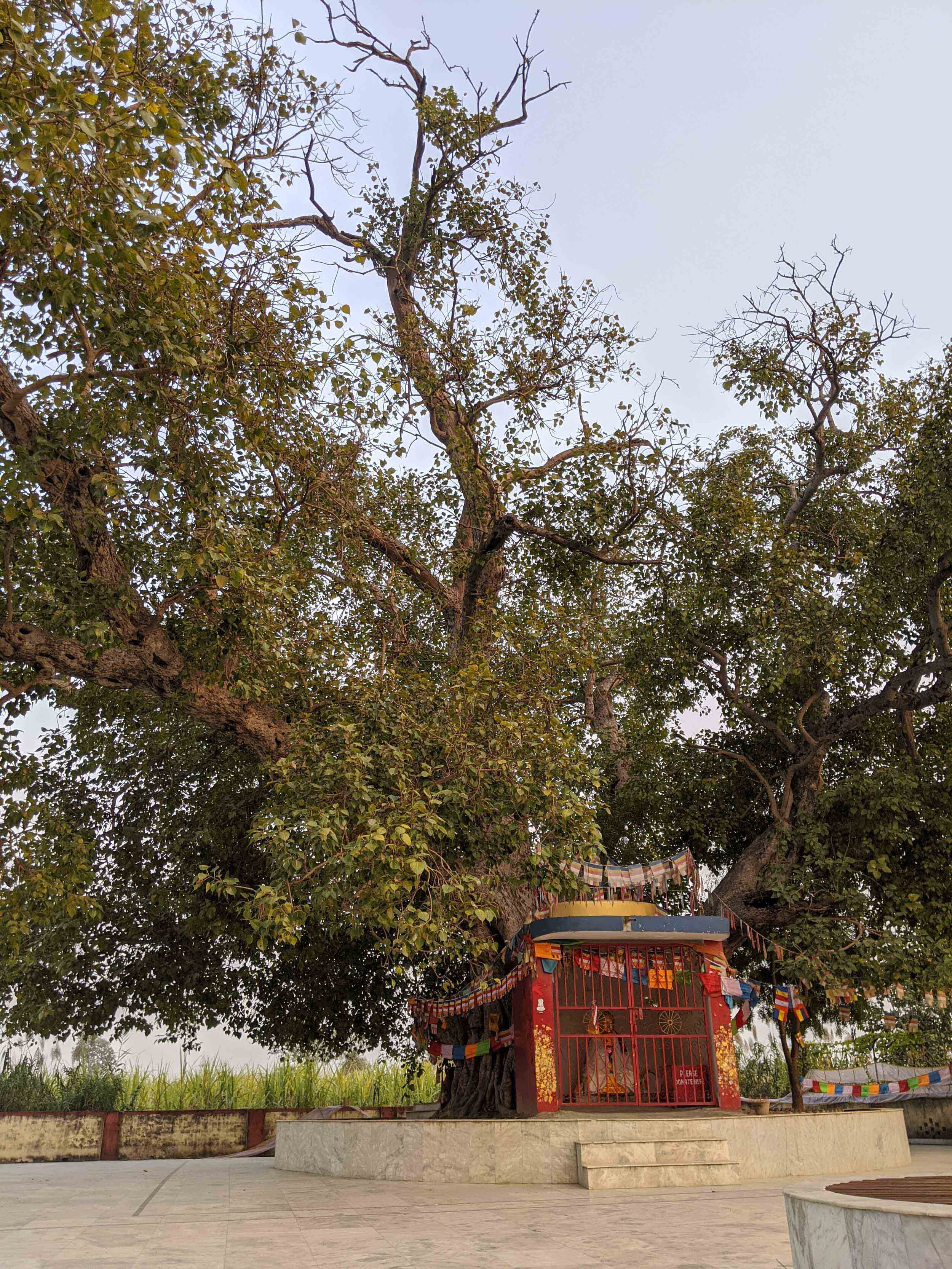
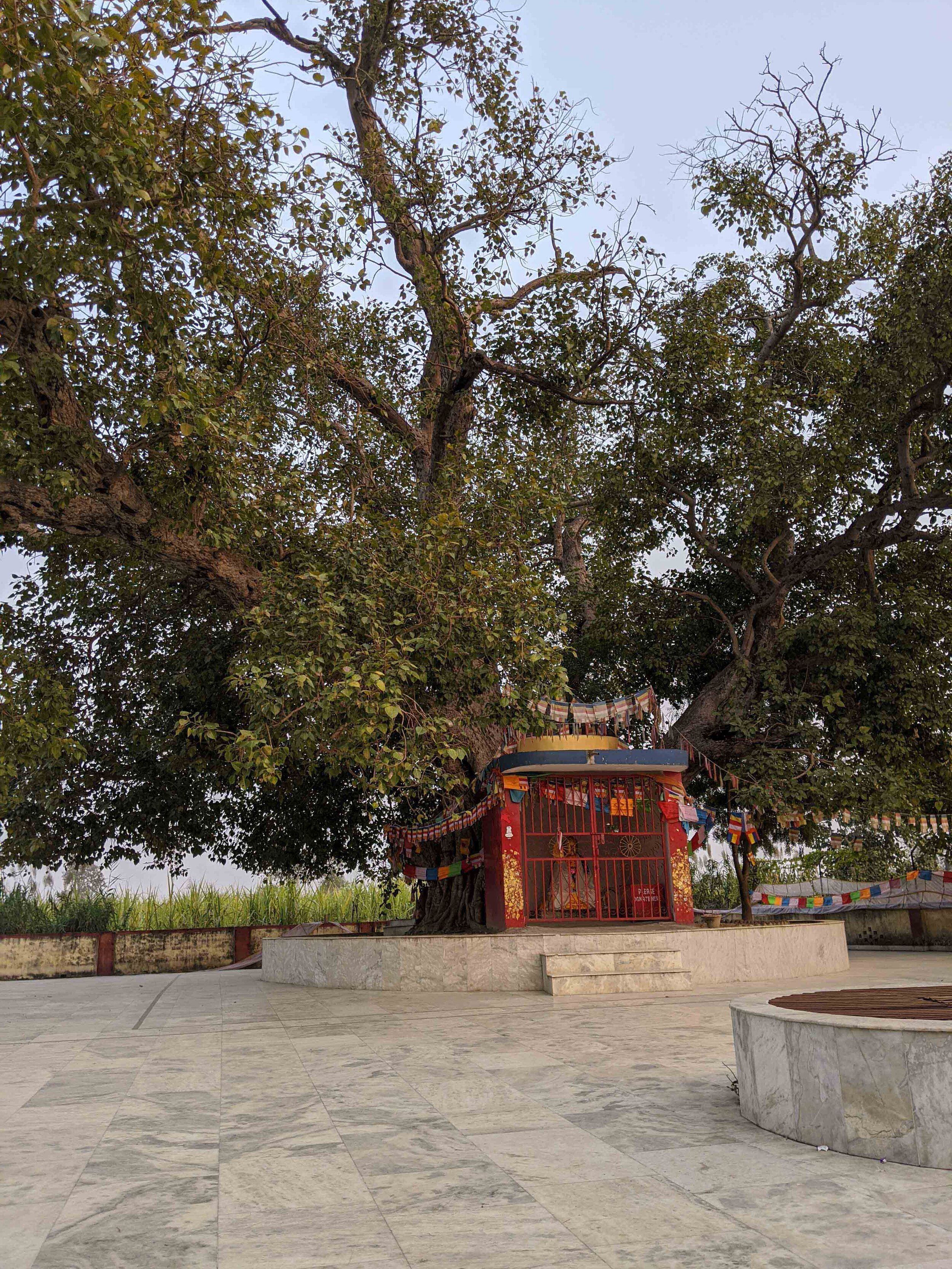
Original Stupas erected over the relics
There were eight stupas erected over 2,500 years ago over the 8 portions of the Buddha’s relics by the…
The Sakyans of Kapilavatthu in Kapilavatthu.
The Thulayans of Allakappa in Allakappa.
The brahman of Veṭṭha Island on Veṭṭha Island.
The Pāvā Mallans in Pāvā.
The Kusinārā Mallans in Kusinārā.
All but one (at Ramagama) had been opened by Emperor Asoka in the 3rd Century BC, as he wanted to re-distribute the relics to 84,000 small stupas thoughout his vast Mauryan empire.
Learn more
Parinibbāna—total unbinding—carries two meanings in the Canon. On the one hand, it denotes the unbinding that happens at the moment of full awakening, either for a Buddha or for one of his arahant disciples. On the other, it denotes the unbinding that happens when such a person dies and is no longer reborn.
The sutta narrates the events of the year leading up to the Buddha’s parinibbāna and the weeks immediately following it.





































